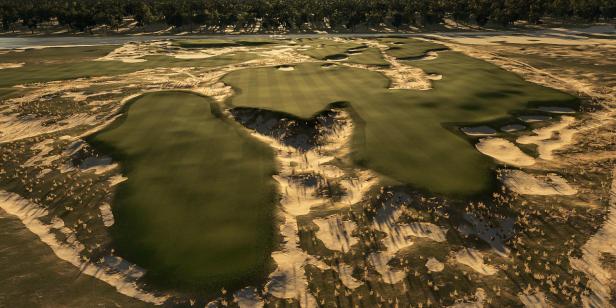Though it’s only January, the biggest golf course news of 2021 might have already dropped.
Virtually any mint-new golf course project is notable these days, but the news of The Lido hit with particular force. Unlike previous samples from the novelty category of “replica courses”—those all-star cornucopias of imitation holes tossed together like chef’s salads, often with little consideration for how they fit with the land—The Lido will be a previously un-attempted effort to recreate an entire golf course in exact form, from routing to shaping to bunkers and hazards.
The course is being built on a level, cleared parcel of land not far from the main entrance to Sand Valley. Tom Doak and Renaissance Golf Design will build the course.
Architects and writers prior to the Depression considered The Lido, for a short period of time, to be one of the game’s most magnificent achievements, a twin wonder of the worlds of golf and engineering. In the decades since it fell, pursuit of The Lido, both theoretical and physical, has been the white whale of many architects and historians.
It was built by architect C.B. Macdonald, who called it his “Long Beach course,” along with construction engineer Seth Raynor. The design was an amalgam of the idealized hole concepts Macdonald developed years earlier at the National Golf Links of America in Southampton (which were themselves based on surveys Macdonald had taken of favored holes in the UK and Europe), and original creations, including several inspired by entries in Country Life magazine’s 1914 “Golf Architecture” design competition, famously won by Alister Mackenzie and whose multi-route par-4 submission Macdonald adapted as Lido’s 18th hole.
The lore of The Lido is indivisible from the fact that it died young, but it’s also based on the fact the course was entirely manufactured, built atop marshes along the Atlantic shore that were filled in with more than 2 million cubic yards of sand and then laboriously topped with layers of malleable topsoil.
Every steep hump, hollow and hummock was orchestrated. And because The Lido was constructed by teams of men and animal across a rectangular site with almost no elevation change, it’s always been considered as a plausible candidate for resurrection in a way not possible for other historic courses. Mike Keiser, founder of Bandon Dunes among other resorts as he has redefined public golf destinations, has long held a desire to rebuild The Lido, going so far as to once seek out possible sites on Long Island. He also explored the possibility doing The Lido on the Old Macdonald property at Bandon Dunes before settling there into an homage to the architecture of Macdonald and Raynor.
As time passed and opportunities seemed to fade, it was Michael who picked up the family cause.
“I sort of went down a rabbit hole about a year ago, deep into the archives that existed of The Lido, and personally gained a much clearer understanding of the architecture,” Keiser told Golf Digest. “I hadn’t realized yet just how strong it was, the individual holes and the routing together, and also how beautiful it would have been in those sandy dunes.”
Though The Lido represents the allure of something lost to some, not to Keiser: “That’s certainly not what drives me. It’s strictly just the quality of the routing and the golf holes. And because it teaches us so much about architecture and that period of time, it’s worth doing in my mind.”
Over the past few years, Keiser had been following the progress of Peter Flory, a financial consultant and part-time golf historian, who was reconstructing a virtual version of The Lido using a 3-D computer gaming format and posting real-time updates on the website golfclubatlas.com. Using photographs, writings and other source material, Flory painstakingly processed each hole, adding a bunker or vegetation here, layers of color there, pixel by pixel, until he had an 18-hole, 360-degree rendering that was his interpretation of The Lido as precisely as he could depict it, down to small contours in greens and fairways.
It’s an impressive, useful piece of artistry, and Keiser contacted Flory to enjoin him in the mission. “Peter Flory had a lot to do with it,” he says. “His renderings did help us sell it.”
The ability of Keiser and his brother, Chris, to show such a comprehensive vision of the course to potential members and investors (the Lido, expected to open in 2023, will be a private course that opens to outside play on selected days) greatly accelerated the financing of the project, estimated to cost $16 million all-in (including clubhouse and infrastructure), by far the most the Keisers have spent on a single course.
“(Flory’s technology) is certainly not one we’ve had access to ever before,” Keiser says. “You can see the holes, you can understand the holes, evaluate them and the golf course, and be inspired by the beautiful images.”
As precise as Flory’s renditions might be, a certain amount of interpretation will be necessary. The existing references, including old photos of a plasticene model Macdonald had commissioned, reveal certain attributes of the putting surfaces, but Macdonald himself noted that the course wasn’t finished exactly to his specifications (and also that it wasn’t quite what it could have been). Building great greens is always about the last few inches of detail, so the scope and subtleties of each putting surface will need to be determined in the field by Doak and his associates.
“That’s one of the many reasons [Doak’s] a perfect fit for the job,” Keiser says. “First of all, he’s got a photographic memory—he’s not only seen more courses on the planet, he’s intimately familiar with every Macdonald and Raynor golf course. We also know the starting point with photos, the plasticene model and the writings of Macdonald that tell us a lot about them.”
Which brings up a more philosophical question: Given certain vagaries about the greens and that no one alive today remembers the course, how will anyone know precisely how close the team comes to executing the original Lido? Since no one with experience can testify to the specific roll of a green, the look of all the carry lines off tees or how much the salty ocean winds contributed to the sensation of playing The Lido, how relevant, ultimately, is accuracy?
We can read a score from Bach and reproduce the sounds, and even listen to them played through instruments of the period to get a reasonably similar experience to the audiences of 1725. Thus, the music lives. But is the same true for a golf course? Can an extinct golf experience pass through time the same way, essentially through photos and plasticene?
These are interesting intellectual exercises, ones such an endeavor invites. But he hasn’t lost the bigger perspective—ultimately they must achieve a golf course worthy of what The Lido represents in the eyes of history.
“You’re right, nobody will know for certain,” Keiser says. “But if you don’t come out and say this is among the very best, we’ll know we didn’t do it accurately. When we stand on each green, I’m going to ask the question, ‘Could this green exist on the greatest golf course in the world?’ And if the answer is ‘No,’ then we’ve got to re-do it. That’s going to be the litmus test that I ask the team.”
And that’s why, from this perspective, The Lido’s greatest chance to reclaim its standing among the country’s greatest courses might not rest in its past, but in its present.
Excellence will come down to the same ingredients that have turned every course and every project the Keiser family has touched into experiences golfers dream about and hold high: An ideal golf site; caring, involved owners; a sense for taking the path less traveled; and a team of architects and shapers who are imaginative, knowledgeable and sweat the details like few others in the business do.
With all that in place, The Lido may indeed rise again.

